

EAP Publications | Virtual Library | Magazine Rack | Search
Join the Ecological Solutions Roundtable
by Linda Gilkeson and Miriam Klein
Table of Contend
The Lifecycle of Beneficial Insects
Transferring Larvae to the Greenhouse .
Care and Feeding of Beneficial Insects 21
Aphids are a major pest in home and commercial greenhouses in North America. This manual is based on three years of research and experience at the Ark Project with biological control of aphids Biological control is an approach which uses beneficial insects and other organisms to control pests and is a preferred method of control in a greenhouse attached to the house. The home-attached greenhouse is an integral part of the home whether it is open to the living area or joined by a doorway. Most of the sprays and dusts that are effective against aphids cannot be used safely in this environment even when all instructions are carefully observed. Sprays and dusts infiltrate the home at the time they are applied, which exposes occupants or contaminates air and food. In addition pesticides must be applied regularly to achieve control and this is a tedious and time consuming chore.
Predators and parasites of aphids are common throughout the world. In Europe and Russia, some of these insects are used in biological control programs in commercial greenhouses. A few species are available from insectaries in North America but since the insects are sent through the mail and open travel long distances. they frequently arrive in poor condition. This is a major obstacle to developing a biological control program, yet some of the most effective predators of aphids are common outdoors in North America and can be collected by anyone interested in biological control.
The first step in pest control is identification of the pest. For this reason, we have devoted a large portion of this manual to descriptions and illustrations of aphids. Being able to recognize aphids in the field is also the key to finding the insects that prey upon them because the predators are most easily located when they are feeding upon aphids. This manual describes the insects to look for and how to collect and use them in small and medium-sized greenhouses. We hope you find it useful in establishing your own greenhouse biological control program
Aphids are tiny, 1-3 mm (1/32"-1/8") long, soft-bodied, pear-shaped insects that suck plant juices. Winged or wingless, they vary tremendously in colour and shape, and feed on almost every type of plant
Most of aphids found in greenhouse crops such as the green peach aphid (Myzas persicae) (MacGillivray, 1979) are pale green, yellow or pink, but outdoors the colours of many species range from bronze and white to dark brown and black with every imaginable shade in-between. Though generally pear-shaped. they may vary from elongated oval to almost round. Winged forms of the same species may appear darker than their wingless counterparts. It is common to see wingless, pale green aphids feeding with black, winged aphids of the same species. The winged aphid is not really black, but appears so because in the winged stage the thorax darkens and the wings which are held roof-like over the body hide the paler abdomen.
Most of the season, aphids reproduce without mating and they give birth to live aphids instead of laying eggs. Females can give birth to live offspring that already have aphids developing inside them. These characteristics give aphids an extremely high rate of reproduction and this is why they are difficult to control with sprays. An entire colony can be generated from one surviving individual. The immature aphid closely resembles the adult and it is common to find aphids of different sizes feeding in the same colony
Aphids are usually found feeding on the growing tips and undersides of leaves, where they congregate in large numbers. Open by the time they are noticed, the aphid colony has formed a dense cover on new leaves and stems. Though they weaken the plant, the most serious damage is inflicted by the viral and bacterial diseases they transmit. The most common symptom of aphid damage is curled, puckered and discoloured leaves. sometimes coupled with wilting. In addition, aphids exude honeydew, a sticky substance that encourages growth of sooty molds. This further damages the plant by shading the leaf surface and in severe infestations, feeding, disease and mold can combine to kill the plant.
Some insects bear a superficial resemblance to aphids. One distinguishing characteristic on most aphids is a pair of tubes resembling tiny exhaust pipes that protrude from their abdomen (see Figure 1). These tubes are called cornices and are usually readily visible, particularly when they are a darker colour than the body. Other characteristic features are that aphids move more slowly than most insects, even when disturbed and they do not hop to escape (as will the similar feat hoppers). They also generally occur in small patches of dense population known as aphid colonies.
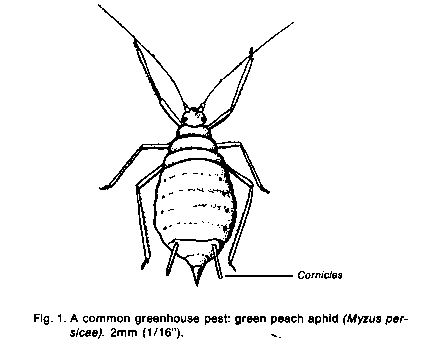
Most insects undergo complete metamorphosis, that is, they pass through four stages of development in their lifecycle: egg, larva, pupa and adult. The first stage, the egg, hatches into a young insect (called a larva) differing markedly in appearance from the adult. Larvae are usually soft-bodied and wingless such as caterpillars. grubs and maggots. They grow larger as they feed, shedding their skins several times When they reach their last stage of development as larvae, the larval skin hardens into a case (called a pupa) which protects the insect while it changes into an adult form. At the end of pupation, the adult emerges from the pupa and flies away to mate and lay eggs, and so completes the cycle.
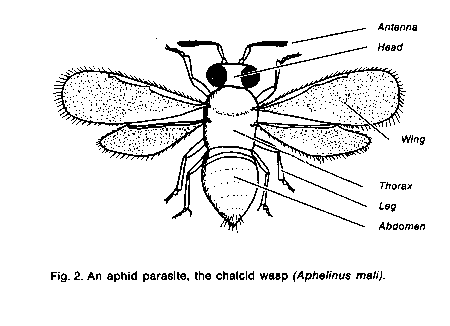
The predatory gall midge is a small, delicate insect. less than 2 mm (1/16") in length. It is native to most of the northern half of the world and is common in North America. The adult has long trailing legs and translucent wings which are large in proportion to its hunched body. The adults are active only at night and during the day they rest on the undersides of leaves.
The female midges search out aphids and lay their eggs beside them. The eggs are barely visible to the naked eye as tiny orange specks. Through a magnifying glass they appear as smooth transparent orange cylinders with rounded ends. They hatch after two or three days into bright orange larvae with segmented bodies which taper to a point at the head (See Fig. 9) They range in colour from pale orange to dark orangered depending on the colour of their prey.
The larvae capture aphids, some of which are many times larger than the larvae, by seizing a leg joint and injecting a paralyzing toxin. They suck the body fluids from the numbed aphid and leave the shrivelled husk still attached to leaf. The larvae feed on aphids for one to two weeks (depending on the temperature) during which time they grow from the size of a pin point to a length of 2 - 3 mm (over 1/16"). They eat from seven to twenty aphids per day, but may kill many more than they eat it aphids are numerous The larvae are known to teed on 61 kinds of aphids.
When fully developed. the larvae leave the plants and burrow into the soil 3 cm (1 1/4') deep to spin a cocoon and pupate. The adults emerge ten days to two weeks later. The adults do not feed on aphids and require nectar for food in order to live more than a few days. The last generation of midge larvae in the fall spends the winter in the soil and emerges in the spring. In a greenhouse, because the days are short, the population will spend December through February in diapause (the insect equivalent of hibernation) in the soil.
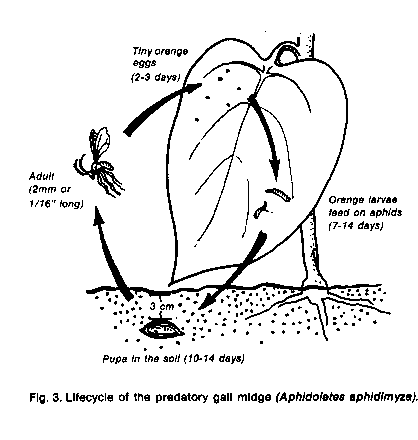
The adult syrphid fly is a large, 13 mm (1/2") long, and beautiful insect whose dark head, dark thorax, and banded yellow and black abdomen more closely resembles the body of a bee or wasp than that of a fly. (See Fig. 4 ) Their habit of hovering like a humming bird and darting from flower to flower (hence the names "Hover Flies" or 'Flower Flies") makes them easy to distinguish from the bees and wasps. They do not sting. The adult fly feeds on nectar and pollen rather than on other insects. The female lays its glistening white eggs singly, close to the developing aphid colony. Visible as minute 1 mm (1/32") oval sausages, the eggs hatch within two to three days. depending on temperature.
The larva is a legless, slug-take maggot. usually a mottled gray, beige or light green colour. varying in length from 1 mm to 13 mm (1/32" to 1/2") depending on the stage of development. (See Fig. 10.) It is easily identified by the pulsating internal organs visible beneath its partially transparent skin. The larva hitches itself along, lifting its pointed head and groping blindly in an attempt to locate its prey Once located the aphid is seized in the larva s mouthparts, the contents are sucked out and the aphid skin discarded In the month it takes for the larva to mature, it can consume hundreds of aphids The brown. tearshaped pupa are usually found on the soil surface though they may also remain on the plant
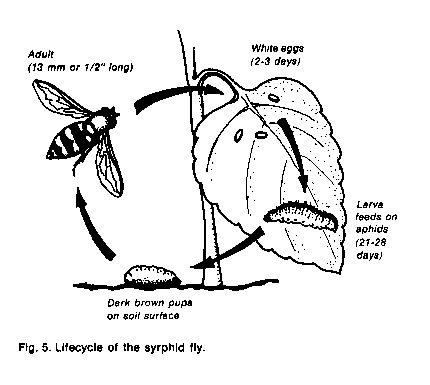
Lady beetles are the best known of all the predators. About 40 of the 370 North American species of lady beetles commonly feed on aphids. These are hemispherical beetles, 5-7 mm (3/16''-5/16') usually orange-red with black spots. Hippodamia convergens is the species that is commonly sold to gardeners. It migrates to the California mountain regions in the late fall where the beetles form large Overwintering colonies. These are collected and sold to gardeners and greenhouse growers for aphid control
Native lady beetles found in the field feeding on aphid colonies can be brought indoors for aphid control. The adult lays its bright orange-yellow eggs in clusters which stand upright and are glued to surfaces such as leaves, branches, sides of pots. etc. The eggs hatch in 3-5 days and the dark brown or black larvae resernble tiny. bristly alligators dotted with orange and yellow spots. After two to three weeks, the larvae pupate on plants. pots or other surfaces. A week to ten days later, the adult emerges. 'caving the pupa case behind
Lady beetles and their larvae are useful predators when there are heavy infestations because they consume as many as 400800 aphids in their lifetime. However, when the number of aphids is low. the lady beetles cannot catch enough aphids to satisfy their voracious appetites. When they are faced with starvation. the lady beetles outdoors will fly away to greener pastures but those in a greenhouse are unable to escape and usually die. Many people have successfully used lady beetles to control aphids in their greenhouses in the spring but they do find that the beetles disappear over the summer.
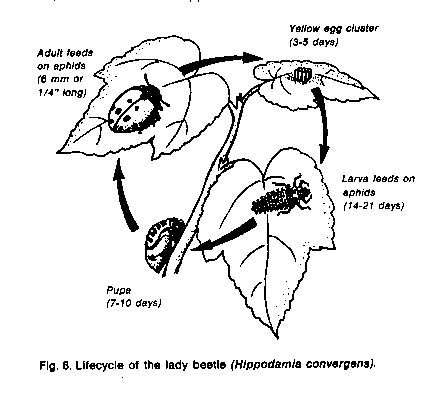
Some species of minute 2 mm (1/16") chalcid and braconid Is also kill aphids by parasitizing them. The female wasp pierces tine aped and lays an egg inside it (see hg. 7.) As the immature wasps grow. they feed on the aphids body tissue, eventually killing the aphid. Because the parasitic wasp larvae feeds on only one aphid. they are effective at very low densities of aphids
After three to four days of feeding. the larva glues the aphid to the leaf with silk and pupates inside the mummy. Aphids parasitized by chalcid wasps are often black and shiny, preserved in their original form, with antennae drawn back and legs solidly positioned on the leaf. The larvae of the braconid wasp spins its cocoon inside the aphid's dead skin giving the aphid mummy a characteristic 'bronzed" or "pearly" appearance. (See Fig. 13.) Five to six days later, the tiny wasp cuts a hole in the back of the dead aphid and emerges. The entire life cycle takes from ten to forty days, depending on temperature The adult wasps feed on honeydew. nectar and exuded plant sap. though they may occasionally feed directly on the aphids
Parasitic wasps are generally more specific in their choice of prey than the predators we have described. This is an advantage in a biological control program when one species of pest is the target but is not as useful in a home greenhouse because it is very difficult to identity the species of aphids and parasitic wasps However, it is worth collecting aphid mummies outdoors and bringing them into the greenhouse on the chance that they will contribute to the control of aphids. These wasps are often attracted into the greenhouse and in some cases have been effective in controlling greenhouse aphids.
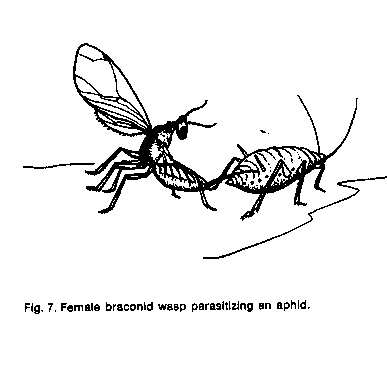
The first step in locating predators and parasites is to find an active colony of aphids. The best time to search for aphids is on spring and summer days when periods of warm and humid weather provide the most favourable conditions for aphids to reproduce. Aphids become very scarce when summers are hot and dry although they can usually be found in relatively moist and cooler parts of the habitat.
Locating aphids also requires knowledge of their life cycle, including which plants they feed on at various times of the year. Different species of aphids prefer different plant hosts. Since there are well over 4,500 species of aphids, the range of plants likely to act as hosts is very wide. Most aphid life cycles take place on two categories of host plants: the plants on which they overwinter, and the summer host plants.
Early in the spring, aphids are found on the winter host plants (usually uncultivated plants) where they hatch from eggs that survived the winter and spend a couple of wingless generations. By late spring, a generation of winged aphids moves to the summer hosts (weeds, ornamental and garden plants) where they go through many more wingless generations. The number of generations depend on temperature and species of aphid. In early fall, another generation of winged aphids moves back to the winter host, mates and lays eggs which will hatch in the spring.
Since the plant species and months of infestation vary from one climatic zone to another, we recommend contacting local entomologists and agricultural extension agents for information specific to your regions.
The following is a list of host plants on which tee have found aphids, predators. and parasites. The plants are correlated with each month of the field study that we conducted on Prince Edward Island.

Search in areas that are the least likely to have been sprayed with pesticides, such as waste land, vacant lots, country roadsides and areas with weeds and wild flowers in bloom. We have found aphids and their predators in old orchards. cultivated fields, wild fields, forests, gardens, roadsides, yards, trees along City streets. and even on a porch plant in the centre at a small city. We found, however, that the largest number of predators of aphids were on plants growing in uncultivated areas. For example, the aphid colonies infesting a weedy, waste strip behind an old packing plant were well populated with predators and parasites.
Search for aphid colonies among, sheltered leaves and branches. Heavy rains and winds we decimate colonies making them difficult to find after a storm. After a few days of fair weather the population will multiply and become more visible again
Look for signs that plants have been damaged by. aphids such as curled or deformed leaves. Gently uncurl these leaves and examine the undersides for aphids at work
Occasionally you may find just the remaining of aphids that have fallen victim to the larvae of the predatory gall midge These predators leave dried-up husks of aphids, which are still attached to the leaf by the mouth parts. These tiny remains resemble brown crumbs and may be the only signs left of former aphid activity. However if you continue searching on the same bush or tree often you will find the current focus of infestation where predators are feeding aphids.
Don't be discouraged, if you do not locate the aphid colony immediately. It takes time to adjust your eyes to the small scale of the insect world.
When you find a colony of wild aphids. hold the tip of the leaf to avoid crushing the insects, and examine the undersides of leaves as well as the growing tips, buds and stems of the plant. (Fig. 8.) A hand lens or magnifying glass (with a magnifying power of 6 to 10 times) is very helpful, Aphids of all sizes, winged as well as wingless forms, may be present along with the shrivelled remains of dead aphids, and various eggs and larvae of predators that have been described. Descriptions in this handbook will help identity what you see.
The larvae. pupa and adult stages of lady beetles are easily recognized. You can either take the whole leaf home or gently lid the larvae and adults with a fine paintbrush into a collecting container. Pupa cases are firmly attached and that section of the stalk or leaf should be removed with the pupa.
Look for the bright orange predatory midge larvae which show up well against light-coloured aphids (see Fig. 8.) Using the magnifying glass. check for eggs on the leaf and for very small larvae that may be attached to the undersides of aphids. These are almost impossible to see with the naked eye.
Syrphid fly larvae are frequently found feeding on aphids in the sheltered, curled portion of leaves. The mature larvae are easier to spot than the predatory midge larvae because they are considerably larger but you must look closely to find the tiny, young larvae. With their pale mottled green or beige colouration acting as camouflage, they blend into the background.
If possible, take entire leaves with aphid colonies and predatory larvae home in the collecting container. This lessens the risk of injuring the soft larvae in transit.
The collecting container can be any container with a wide mouth and a lid. A shoe-box or plastic food container is ideal. Glass containers can be used but they are heavy and breakable and will heat up inside in the sun. If used. a glass container should be wrapped in paper to shade the contents.
Never leave the container in the sun while on a collecting trip as overheating will quickly kill insects. Keep the collection as cool as possible (12-16°C/55-60°F) and transport it to the greenhouse without delay. On very hot days or for long periods in transit. it is advisable to keep the container of insects on ice in a cooler or insulated box.
Occasionally a large number of beneficial insect larvae can be collected in the field, but incubating colonies of aphids is another technique for accumulating larvae, especially when very few beneficial larvae can be found. Aphid-infested plant material can be taken home and held at room temperature for two or three days. This often reveals a surprising number of aphid predators that were either too small to be seen or were hidden under aphids. In 1973, Harris found that on the average only 11 percent of the predatory midge larvae present in a sample could actually be seen in the field.
Place a portion of the infested plant with aphids on ~ such as the tip of a branch with three or four leaves. in a plastic bag Blow into the bag to fill it with air and twist-tie it closed. Place the bag out of the direct sun and leave it for two or three days. Keep the bag filled with air so that the moist sides won t collapse onto the plant material. After a few days. hay larvae that were hidden among the aphids will have grown ago migrates.- to the sides of the bag where they are visible In one sample taken during a field study. only four predatory midge larvae were visible in the field. yet after waiting three days, thirty-three larvae were found clinging to the bag. Even samples that appeared to contain no larvae yielded predatory midge larvae after a few days of incubation.
Once you have located beneficial insects or larvae, whether in the field or after incubating a bagged plant sample, they must be moved to the greenhouse. Use the moistened tip of a very fine paintbrush to gently lift the larvae from the leaf or sides of the bag and place them among aphids in the greenhouse. It is important to place them in a shady spot initially because they can die in the sun before they recover from the shock of being handled
You should avoid transferring obviously abnormal larvae into the greenhouse Although we have experienced no problems in this regard, shrivelled. flaccid or distended larvae should be discarded because they could be suffering from disease or from parasitization by their enemy insects.
Dispose of the bag with the plant sample or leaves from the field away from the greenhouse to prevent the wild aphids from infesting greenhouse plants.
The number of aphid predators you find will depend on the time of year, the environmental conditions and your patience. The more predators you release into the greenhouse, the sooner the aphids will be controlled. Introducing a mixture of different aphid predators has its advantages but there should be enough at least one species to maximize its chances of reproducing and becoming established
In most regions, there are several different species of syrphid flies and lady beetles and it would require a trained entomologist to determine whether all the insects collected were of the same species However. if a large number of larvae are collected at one time from a small area such as one plant or tree, they are usually of the same species. The number of syrphid larvae in some samples is surprisingly high and occasionally large numbers of native lady beetle larvae are found on aphid-infested trees in cities. Fifty or 60 larvae can be collected in these cases which can be an effective number in a small (61 m2 or 200 ft2) greenhouse.
Although there are several species of all the beneficial insects described. there is only one species of predatory midge (Aphidoletes aphidimyza) that is common. and of all the beneficial insects found in the field study, it was the most numerous. They seem to be particularly good candidates for collection from the wild because a few individuals reproduce quickly in a warm greenhouse environment. We suggest that you concentrate on collecting at feast 50 of these larvae for a small greenhouse.
Unless you are able to collect several hundred larvae at once (which is possible in some situations} the first predators you release may not control the aphids, but their offspring, the next generation, wilt have an impact on the aphids. For example. if you collected 50 predatory midge larvae and put them among aphids in a warm greenhouse. in as little as 14 days, the eggs of the next generation could start to hatch into voracious larvae. possibly as many as 80-100 larvae per original female (about half the population) This might give you 1.500 to 2.000 larvae in the next generation under good conditions
Where aphid populations are low initially. the second generation may control the aphids adequately If aphid populations are high (numerous aphids on every plant or greater than 5 percent of the plant surfaces affected) then many more larvae or several generations will be necessary to control the aphids.
The best chance of establishing aphid control when confronted with a high population is first to spray the greenhouse with a non-residual spray such as the insecticidal soaps or wettable powder rotenone in water . After this kills as many aphids as possible, wait two to three days and spray the plants with water to wash the leaves. Then put in the aphid predators you have collected. This method reduces the number of aphids and prevents plants from being damaged further during the time needed for the predators to reproduce,
The goal is to establish a year-round population of beneficial insects, and you can continue to add beneficial insects to the greenhouse whenever you find them. As you become familiar with the beneficial insects and their various immature forms, you should be able to determine which insects are most effective in your greenhouse.
Since the most important reason for introducing beneficial insects into the greenhouse is to provide long lasting pest control, it is essential to protect and care for them in that environment. The following points are important in maintaining a successful biological control program:
1 Screen vents. Screen all openings and vents in the greenhouse to keep beneficial insects inside. The benefits of unscreened vents such as better air circulation, free entry of wild beneficial insects and economy in a home greenhouse are far outweighed by problems caused by pests such as mice that enter through lower vents, and night-flying moths, attracted to lights in the home. that enter through upper vents. These moths lay eggs that hatch into very destructive caterpillars.
2. Don't use pesticides. Most garden pesticides (including the botanical pesticides such as rotenone. pyrethrum. and Diatomaceous earth) will kill beneficial insects. It necessary, individual plants or small areas of the greenhouse may be treated carefully with a pesticide. For example. a potted plant could be removed from the greenhouse entirely and sprayed outdoors, General spraying or fumigation is not only unnecessary to control pests but will be fatal to your biological control program.
3. Feed your Insects. The larval stages of beneficial insects feed on aphids but the adults usually require food such as pollen or nectar to survive and to reproduce An essential part of establishing the colony includes providing a few flowering plants. These can be grown directly in the beds or in pots or planters around the greenhouse. Plants with small flowers are necessary because the insects are small and cannot feed in large flowers Dill is ideal for this purpose because it grows quickly from seed Perennials such as lemon balm (Melissa officinalis) pennyroyal (Mentha pulegium) and sweet clover (Melilotus officinalis) are excellent as are the weeds--Queen Anne's Lace (Daucus carota) and wild parsnip (Pastinaca sativa) Many vegetables and flowers grown In a home greenhouse also serve as sources of pollen especially if a few such as parsley broccoli or celery. are allowed to run to seed when past their prime as food crops
4. Provide water. Most beneficial insects need water and in humid areas this is provided by condensation on glazing or droplets on leaves In dry regions a source of water that won't trap and drown tiny insects should be provided A roll of cotton cloth plugging the top of a bottle or water will act as a wick and stay wet enough to allow insects to drink safely
5. Protect your insects. Care must be taken not to destroy the pupae of the beneficial insects in their resting places. Lady beetles usually lay eggs and pupate on the sides of pots, flats and benches and can be easily injured when pots are moved. The syrphid flies pupate in or on the top layer of soil and the predatory midges pupate about an inch below the soil surface. Soil fumigation or pasteurization kills pupae of both these insects and excessive soil cultivation will injure them.
Beneficial insects must be protected from other insects and spiders that prey on them. For example, releasing general insect predators such as preying mantids would be unwise because they will eat the larger beneficial insects before feeding on aphids. Spider webs near the glazing will snare hundreds of the predatory midges. Keep webs swept away at all times. Many midges also die at night by flying against incandescent light bulbs left burning in the greenhouse.
In northern latitudes when the days get shorter in the fall and temperatures drop in the greenhouse, beneficial insects in the greenhouse will start hibernation. This is particularly true in most areas of Canada where short days and cold winters cause many home greenhouses to be cool Winter care of the insects will depend on the conditions in your greenhouse.
1. If the temperature in your greenhouse goes to freezing ore below for most of the winter, chances are the native, beneficial insects will survive as they will either hibernate in the soil or in cracks and crannies. Under these conditions, aphids are not a problem during winter even if a few hardy plants remain in the beds. Only your own experience will tell you if your predators emerge at the same time you begin to have a problem with aphids in the spring. One of the benefits of working with indigenous insects is that they are hardy enough to survive until the next spring and will be active months earlier in the greenhouse than those that are out of doors.
2 If your greenhouse is cool, but not below freezing at night, is warm during the day and has plants in it all winter, there will probably be a few aphids reproducing somewhere, but at a slow rate Under these conditions the native insects will still hibernate during December. January and February, because short day length along with cool temperatures is their cue to hibernate. In February. aphids usually start reproducing and may need to be controlled by sprays before the predators emerge
For this purpose we recommend several options
(a) a hard spray of water
(b) insecticidal soap sprays which are effective against aphids and do not harm lady beetles (their effects on predatory midge and syrphid larvae has not been determined), (c) wettable powder rotenone spray. Use extreme caution and don't breathe dust while mixing; rotenone in dust or powder corns is not recommended
(d) manual control -- hand picking a few aphids. pulling out an infested plant.
(e) seaweed extracts used as a foliar spray to repel aphids.
Before you spray. examine the aphid colonies with a magnifying glass for eggs and larvae of predatory midges and syrphid flies in case they have already laid eggs among the aphids If eggs or larvae are present. it is not advisable to spray because you could harm them directly or you could deprive the emerging larvae of then food supply at a critical time in their lifecycle
DO NOT USE systemic insecticides, general fumigation or pesticides other than those listed above in the greenhouse. It can end your biological control program although it is not very likely to end the pest problem (predators and parasites generally are more susceptible to pesticides than their prey) and these pesticides are neither registered for, nor are they safe to use in close proximity to living areas
Avid greenhouse gardeners who have an area of their greenhouses equipped with gro-lights to lengthen the winter light periods and heating cables to keep seedlings warm may find that they have a colony of predatory midges or parasitic wasps that remain active all winter in this artificial springtime climate. Adults from this colony will be the first to set forth into the greenhouse Provide them with nectar, pollen and a water supply in the lighted area just as you would if it were summer and you could have an early host of predators on hand for the first appearance of aphids in the spring.
Further Reading
Addresses of Authors
MacGillivray, M.E. Aphids infesting potatoes in Canada: life cycle and field key. Research Station, Fredericton, N.B. Information Services, Agriculture Canada, Ottawa. K1A 0C7. 1979.
Harris, K.M. Aphidophagous cecidomyiidae (Diptera) taxonomy, biology and assessments of field populations. Bulletin Ent. Research, 63:305-325, 1973.
Jordan, William H. Jr., Window Sill Ecology, Rodale Press, Emmaus, PA, 1977.
Savigear, Elfrida, Garden Pests and Predators, Thorsons Publishers Ltd., Wellingborough, Northamptonshire, England, 1980.
Swan, Lester A. and Charles S. Papp, The Common Insects of North America, Harper & Row, New York, 1972.
Westcott, Cynthia, Ed., Handbook on Biological Control of Plant Pests, Brooklyn Botanic Gardens, Brooklyn, N.Y. 11225. Copyright 1960.
Linda Gilkeson R.R. #1, Souris Prince Edward Island Canada COA 2B0
Miriam Klein Memphremagog Group P.O. Box 456, Newport Vermont, U.S.A. 05855
Copyright © 1981
Info Request | Services | Become EAP Member | Site Map
Give us your comments about the EAP site
Ecological Agriculture Projects, McGill University (Macdonald
Campus)
Ste-Anne-de-Bellevue, QC, H9X 3V9 Canada
Telephone:
(514)-398-7771
Fax:
(514)-398-7621
Email: eapinfo@macdonald.mcgill.ca
To report problems or otherwise comment on the structure of this site, send mail to the Webmaster